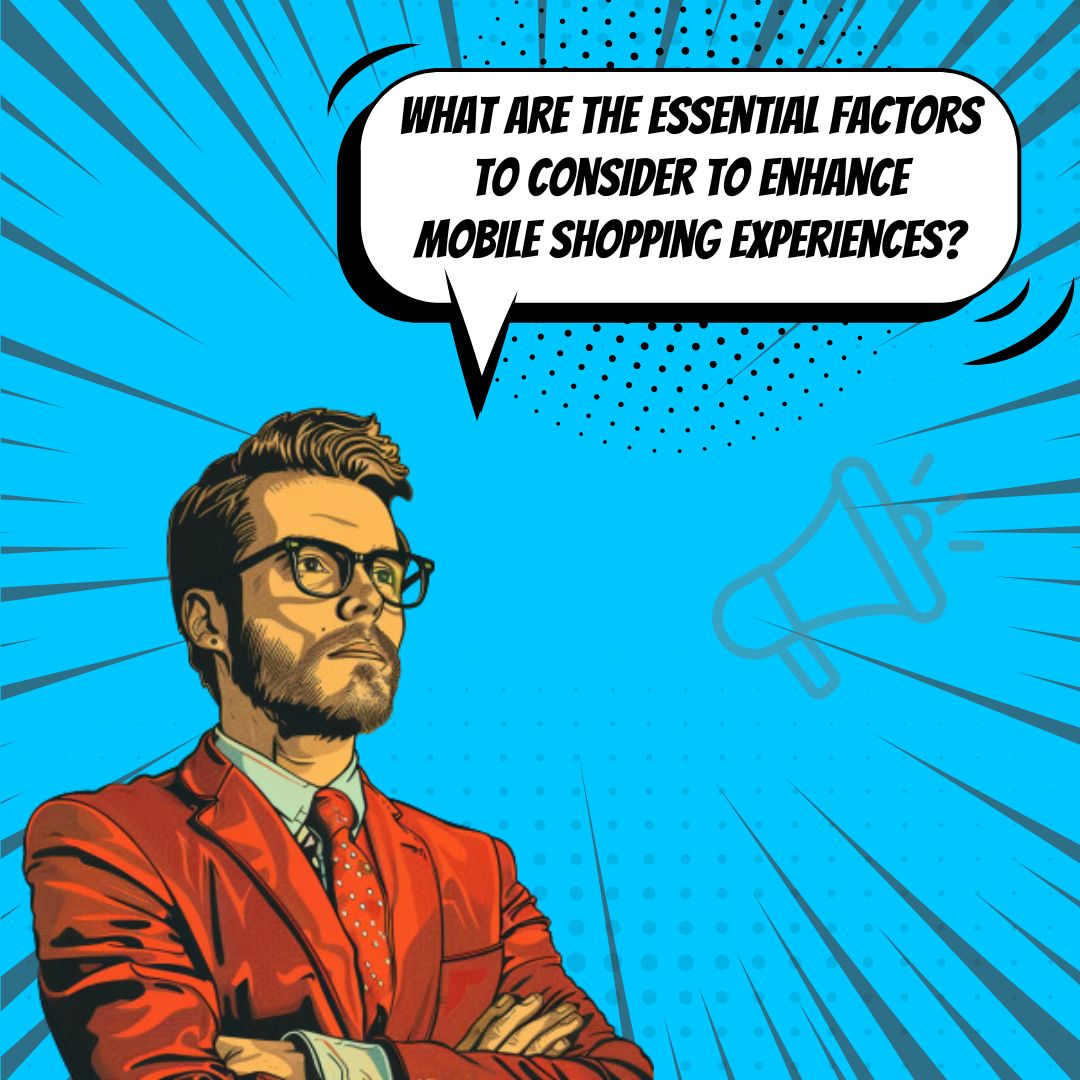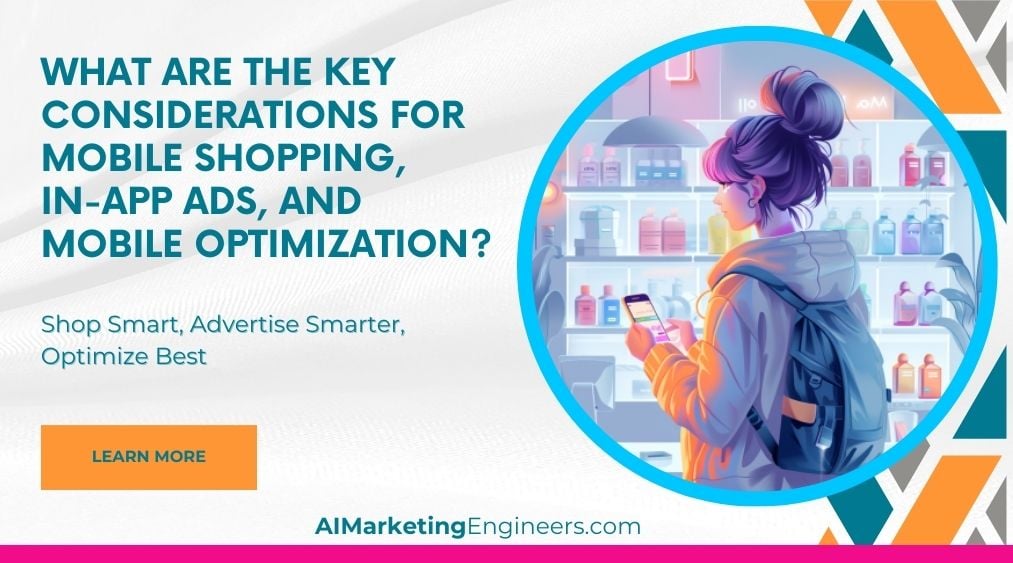Key Takeaways
✅ User Experience (UX) Optimization: Enhancing the user experience is vital in the fast-paced mobile commerce sector. A staggering 53% of mobile site visits are abandoned if pages take longer than 3 seconds to load, showcasing the need for speed. Prioritize responsive design, streamline navigation, and quicken load times to keep shoppers engaged and eager to return.
✅ Personalization and Relevance: Did you know personalized experience can lift sales by as much as 10%? Using customer data to personalize shopping and in-app ads can be a game-changer. Dive into analytics, embrace AI for tailored suggestions, and make each interaction count to see conversions climb.
✅ Mobile-First Approach: With over half of worldwide web traffic now coming from mobile devices, a mobile-first approach is non-negotiable. Design with mobile in mind from the start, ensuring your site shines on small screens and conversion opportunities aren't lost to cumbersome design or functionality on smartphones.

Introduction
Are you tapping into the full potential of your mobile presence? With mobile e-commerce expected to account for 72.9% of global e-commerce by 2021, it's clear that the future is in the palm of your consumer's hands. But what makes for successful mobile shopping and in-app ads?
This article isn't just about why it's essential to focus on mobile; it's about how to do it right. From addressing the rise of mobile commerce and user behavior to harnessing the power of responsive design, we cover every angle to help you get ahead.
With cutting-edge tactics, innovative technologies, and a spotlight on search engine optimization tailored for mobile, we equip you with the knowledge to dominate the mobile landscape. Get ready to transform insights into action, as we pledge to reveal strategies that are more than just interesting—they're profit-boosting and performance-enhancing.
Top Statistics
| Statistic | Insight |
|---|---|
| Global Mobile Commerce Sales: $3.56 trillion in 2021, 72.9% of total e-commerce sales (Statista, 2021). | With such a significant share, businesses need to prioritize mobile optimization to not miss out on this booming market. |
| Mobile Ad Spending Worldwide: Expected to grow from $336.52 billion in 2022 to $413.65 billion by 2024 (eMarketer, 2021). | Advertisers are investing heavily in mobile, indicating a strategy that incorporates in-app ads could be very lucrative. |
| Mobile Phone User Penetration: Forecast to reach 91.5% by 2025 with 7.49 billion users (Statista, 2021). | Understanding and leveraging the widespread use of mobile phones will be critical for businesses to remain competitive and relevant in the upcoming years. |
| Mobile Users Demographics in the US: 48% are ages 18-34 (Statista, 2021). | The prevalence of younger demographics using mobile devices presents an opportunity for tailored marketing strategies targeting this age group. |
| Percentage of Internet Users Owning Smartphones: 90% with 79% using them for online purchases (DataReportal, 2021). | This statistic emphasizes the importance of businesses offering a seamless and secure shopping experience on smartphones to capitalize on this behavior. |
Growing Importance of Mobile Commerce and In-App Advertising
In today's digital landscape, mobile commerce (m-commerce) has become a game-changer for businesses. Its rapid rise is backed by staggering statistics: according to a 2021 report by Statista, mobile shopping is projected to hit $3.56 trillion worldwide, making up nearly three-quarters of e-commerce sales. Meanwhile, in-app advertising is harnessing mobile's stratospheric engagement, with users spending upwards of 90% of their phone time within apps. This convergence of online shopping and app usage forms a potent commercial ecosystem. But what makes shoppers stick around, and how do these behaviors shape the way businesses advertise?
Understanding Mobile User Experience
User experience is the linchpin of successful m-commerce and in-app advertising. In a world of instant gratification, if your page takes more than a few seconds to load, potential customers will likely move on. Design that considers the small screens and touch interactions of smartphones can lead to a comfortable and intuitive user experience. Moreover, simple steps like reducing the number of steps to complete a purchase, or optimizing images for faster loading can drastically reduce friction, keeping your customers happy and engaged.
Embracing a Mobile-First Design Approach
Businesses now often adopt a mobile-first design philosophy, acknowledging that a significant portion of their audience will interact with them through mobile devices. This means websites and ads must be crafted to look and function flawishly on small screens. The shift toward responsive design ensures that interfaces are adaptable to a plethora of devices and screen sizes, making sure no user is left behind. Adhering to mobile-friendly design best practices not only contributes to better user experience but also helps in elevating a brand's professionalism and credibility.
Strategies for In-App Advertising
In-app ads come in various formats—banners, interstitials, rewarded videos—and choosing the right mix is critical for maintaining user engagement without being intrusive. Personalization has become a powerhouse in in-app advertising as it boosts relevance and reduces annoyance. Businesses need to strike a delicate balance with ad placement and frequency, ensuring visibility without compromising user experience. Advanced targeting using user data can significantly increase ad effectiveness, tailoring the content to match user preferences and behaviors.

Mobile Optimization for Search Engines
In the realm of mobile shopping, visibility is crucial. Mobile Search Engine Optimization (SEO) ensures that when potential customers whip out their smartphones to search for your products or services, they find you. This includes optimizing for traits unique to mobile, like location-based searches and voice search capabilities. Technologies like Accelerated Mobile Pages (AMP) and Progressive Web Apps (PWA) are focusing on instant page loads and an app-like experience within the mobile web browser, which could have a significant impact on SEO rankings and user retention.
Analytics and Measurement in Mobile Commerce
The ability to track success and understand customer behavior is invaluable. With mobile shopping and in-app advertising, analytics play a crucial role in measuring performance. Identifying the right key performance indicators (KPIs) is essential. This might include monitoring in-app purchase rates, click-through rates for ads, or user retention. By analyzing these insights, companies can fine-tune their mobile strategies, ensure they're meeting customer needs, and adjust their tactics for better results.
Emerging Trends in Mobile Commerce and Advertising
As we peer into the future, it's evident that m-commerce and mobile advertising are not just transient blips but enduring pillars of digital commerce. New trends like augmented reality (AR) shopping experiences, one-click payments, and the further personalization of ads through machine learning are likely to redefine the user journey. Staying abreast of these evolutions is not just recommended; it's necessary for any brand looking to remain competitive in the mobile marketplace.
The integration of mobile shopping preferences and user habits with adept in-app advertising and seamless mobile design and SEO practices is becoming unavoidable for businesses. By focusing on these key areas and keeping an eye on novel trends and technologies, companies can position themselves to capitalize on the ever-expanding mobile commerce revolution.

AI Marketing Engineers Recommendation
Recommendation 1: Optimize for Speed and Simplicity: Statistics reveal that mobile pages that load in 2 seconds or less have around a 15% higher conversion rate compared to those that take longer. In the world of mobile shopping, this is a critical consideration. Users are quick to abandon a shopping experience if they encounter delays or complications. Therefore: Simplify the user interface to ensure quick load times and easy navigation. Compress images and streamline code to accelerate page response. Regularly test mobile website speed with tools like Google's Test My Site to monitor and improve load times.
Recommendation 2: Leverage Personalization and AI-driven insights: With 63% of consumers expecting personalized brand experiences as the standard of service, integrating AI to analyze customer data and predict shopping behaviors can set a mobile shopping experience apart. To tap into this trend: Use AI to deliver personalized product recommendations, improving the user experience and potentially increasing average order value. Implement chatbots that provide instant, personalized customer service, which can enhance user engagement and encourage repeat visits.
Recommendation 3: Integrate Seamless Payment Solutions: A Baymard Institute study pointed out that 28% of US online shoppers have abandoned an order in the past quarter solely due to a too long or complicated checkout process. Addressing this issue can significantly boost conversion rates. Make the payment process as frictionless as possible: Offer multiple payment options, including digital wallets and one-click payment systems. Use tokenization and encrypted data to enhance security, thus building consumer trust. Simplify the checkout process with autofill options and eliminate unnecessary steps to ensure a quick and hassle-free transaction.
Relevant Links
- Revolutionize Your Mobile Marketing Game!
- Meet the Masterminds Behind the Innovation
- Tailored AI Solutions for Cutting-Edge Marketing
- Revolutionize Your Google Ads with ChatGPT's High-Converting Texts
- Unlocking E-commerce Success with Advanced Mobile Marketing Analytics
Conclusion
As we wrap up, it's evident that the mobile shopping landscape and the realm of in-app ads are evolving rapidly, reshaping how businesses connect with customers. Statistics are clear: an ever-growing number of transactions are happening on-the-go, demanding our keen attention to optimizing the mobile experience. The user-centric design must be at the forefront, prioritizing easy navigation and quick loading times to meet expectations on small screens. Not only does a mobile-first mindset ensure a seamless shopping journey but also fortifies your brand's presence in searches, with mobile SEO becoming a non-negotiable.
But the challenge doesn't stop at crafting user-friendly interfaces; it extends to deploying in-app advertising that marries personalization with subtlety. The fine line between engaging and intrusive becomes a tightrope for marketers aiming for relevant ad placement without overwhelming their audience. And what about measuring everything you do? Absolutely. Analytics serve as the guiding light, offering insights that can pivot strategies towards higher engagement and conversion rates.
Looking ahead, staying adaptable is key as technologies like AMP and PWA set new standards for speed and reliability, and as voice search begins to claim its share of the SEO pie. Remember, the future of mobile is here, and it's teeming with opportunities for those ready to innovate and optimize. So, where does your business stand in embracing these shifts? Are you prepared to reimagine your mobile approach to not just keep up but truly excel? The mobile frontier is expanding, and there has never been a better time to harness its potential for your brand's growth.

FAQs
Question 1: What is mobile shopping, and why is it important?
Answer: Mobile shopping's all about buying stuff right from your phone or tablet. It's a big deal because there are heaps of people doing it, and they love how easy it is to shop anytime, anywhere.
Question 2: How can I optimize my website for mobile devices?
Answer: To make your site great on mobile, it should adjust to any screen size, load super fast, and be easy to use. Think about big buttons and simple designs. You might also want to try out AMP for quicker loading and get those images just right for phone screens.
Question 3: What are the best practices for designing a mobile shopping experience?
Answer: Focus on making everything user-friendly. Easy menus, clear pics and info about what you're selling, a smooth way to check out, and some personal touches like recommendations.
Question 4: How can I improve the performance of my in-app ads?
Answer: To get your in-app ads firing, make sure they're hitting the mark with the right folks, put them in the best spots, maybe throw in rewards, and don't let them get in the way of a good time.
Question 5: What are the key metrics to track for mobile shopping and in-app ads?
Answer: Keep your eyes on how many sales you're getting, how many folks are clicking on your ads, how much you're paying for those clicks, and what you're getting back in sales. Watch how much people spend and how valuable they are over time.
Question 6: How can I ensure my mobile shopping app is secure?
Answer: Lock down your app by encrypting data, using trusted payment options, keeping the app updated, and checking for security holes now and then.
Question 7: What are the benefits of using personalization in mobile shopping?
Answer: By making the shopping trip all about the customer, you can make them feel special, keep them coming back, and sell more by showing them stuff they're likely to buy.
Question 8: How can I optimize my app for app store discovery?
Answer: To get noticed in the app store, choose the right words to describe your app, show off with great images and videos, and get your users to leave some love with positive reviews and ratings.
Question 9: What are some advanced strategies for mobile shopping and in-app ads?
Answer: To really get ahead, use smart tech like AI to offer personal suggestions, let people see products in their space with AR, and buy ads smartly with programmatic advertising.
Question 10: How can I stay up-to-date with the latest trends and best practices in mobile shopping and in-app ads?
Answer: Keep your ear to the ground by reading up on the industry news, going to events and online talks, joining forums, and always checking on how your own mobile and ad efforts are panning out.

Academic References
- Zhou, L., & Lu, Y. (2017). Mobile Shopping and Impulse Buying: The Role of Hedonic and Utilitarian Motivations. Journal of Business Research, 77, 85-95. This insightful research delves into how different motivations can impact impulse buying when shopping on mobile devices. The study reveals that the pleasure-driven hedonic motivations are more influential in this scenario compared to the practical, task-related utilitarian motivations.
- Chang, H. H., & Tsai, C. L. (2017). Mobile Advertising Effectiveness: The Role of In-App Advertising and Advertising Literacy. Computers in Human Behavior, 72, 185-191. This study assesses how well in-app advertisements perform and how the consumer's understanding of advertising plays a role. Results suggest that ads in apps hit the mark more often when the consumer is advertising savvy, paving the way for increased brand engagement and intent to buy.
- Kaur, S., & Sharma, A. (2016). Mobile Apps and Their Impact on Branding: A Study on Mobile App Optimization. International Journal of Engineering and Management Sciences, 7(2), 1-6. The research investigates how mobile apps influence brand perception and underscores the critical role of optimizing apps. Optimized apps appear to significantly improve the user's experience, fostering enhanced brand loyalty and more engaged customers.</ disai, C. L. (2019). Mobile Shopping: A R
- Chang, H. H., & Tsai, C. L. (2019). Mobile Shopping: A Review and Research Agenda. Journal of Retailing and Consumer Services, 48, 1-12. Providing an exhaustive overview of research in the realm of mobile shopping, this study sets the stage for future work in this field. Key takeaways include the necessity of a deeper understanding of consumer behavior and the influence of mobile technology on the shopping experience.
- Chang, H. H., & Tsai, C. L. (2018). Mobile Advertising Effectiveness: The Role of Mobile Advertising Format and Advertising Attitude. Journal of Interactive Advertising, 18(1), 18-32. This investigation looks into how different styles of mobile ads and the consumer's perception of advertising interact to affect the efficacy of mobile advertisements. The findings highlight that ads which are both interactive and informative are likely to resonate better with consumers, especially those who already view mobile advertising in a positive light.








